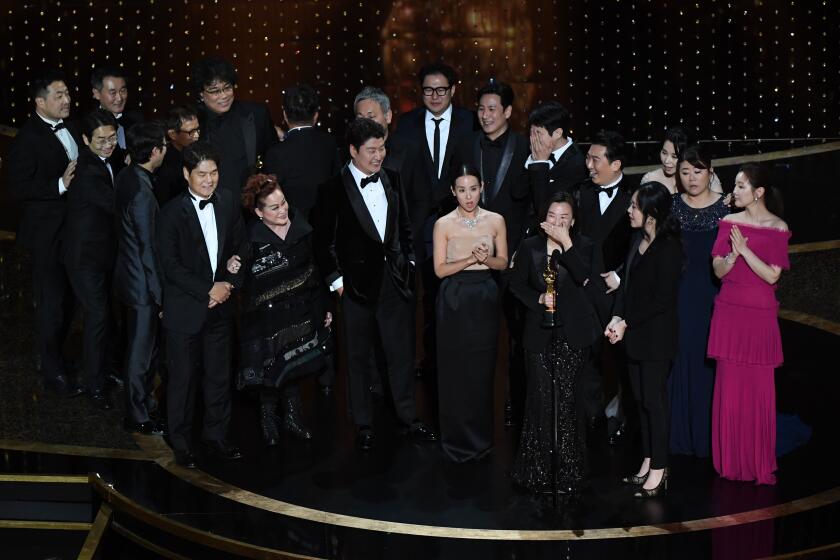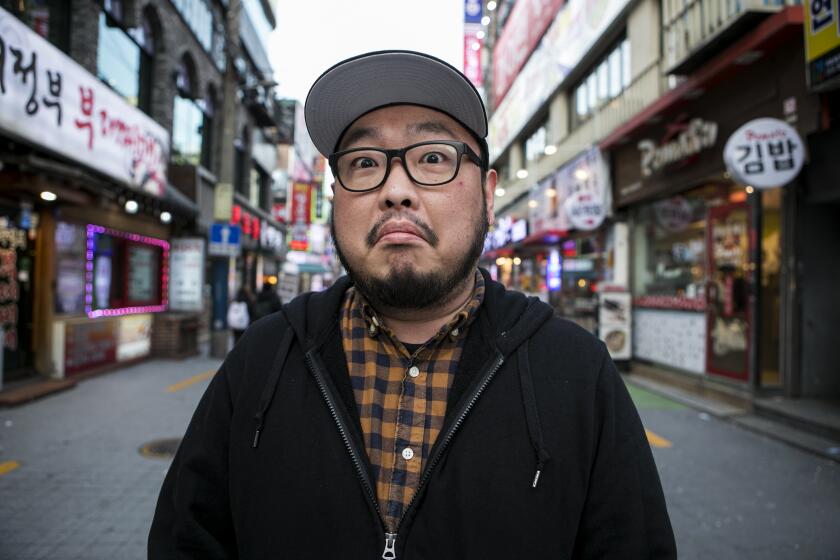The halfway underground homes of ‘Parasite’ are real spaces of desperation and dreams
SEOUL — For nine years, South Korean poet Shin Hyun-rim and her daughter resided in a netherworld seven steps below the street.
In the heart of Seoul, a stone’s throw from the presidential residence and skyscrapers housing the likes of Samsung, Shin and her daughter lived in a banjiha — a semi-basement apartment with scant sunlight and dirt-cheap rent, that for many South Koreans is a last resort, a rite of passage or a low-slung pit stop on the way to something better.
For the record:
7:01 a.m. Feb. 14, 2020This article misstated the number of South Koreans living in semi-basement homes as “more than 36,000.” The correct statistic is: More than 360,000 households lived in semi-basement homes as of 2015, the year from which the most recent figures are available.
“You can’t tell whether it’s night or daytime,” said Shin, 58, who moved to a fourth-floor walk-up about two years ago. “It’s a good place to dream. Your imagination is what gets you through it.”
The halfway underground banjiha home figures prominently in South Korean director Bong Joon Ho‘s dark comedy “Parasite,” a stark depiction of the rock-bottom existence the movie’s Kim family tries to claw out of and then descends back into. Bong has said the tantalizing in-betweenness of the semi-basement was a major inspiration in making his thriller exploring class disparities, which has connected with audiences around the world and made history at Sunday’s Oscars by becoming the first non-English-language film to win best picture.
“Banjiha is a space with a peculiar connotation.... It’s undeniably underground, and yet you want to believe it’s above ground,” Bong said last May after the film’s premiere at the Cannes Film Festival. “There’s also the fear that if you sink any lower, you may go completely underground.”
Bong said the film’s translators struggled to find the right word in English and in French because there wasn’t a direct equivalent. They ultimately settled on “semi-basement.”
For many in Bong’s native South Korea, the film brought back memories of months or years spent in banjiha dwellings — the bleakness, the critters, the moldy smell that comes from a perennial dampness. Like Hong Kong’s cage homes and Brazil’s favelas, the banjiha in many ways has come to symbolize a segment of South Koreans squeezed by increasing density and diminishing affordability, crammed into unseen corners of a city where the rich keep getting richer and occupy more and more of the space.
“I must have wanted to lock away the semi-basement in the basement of my subconscious,” one South Korean blogger wrote, saying she’d forgotten she lived in one as a graduate student until she saw “Parasite.” “My self-esteem dropped exactly as much as the ground was high against the window.”
With “Parasite,” the academy gave best picture to the actual best picture. It also made history.
More than 36,000 South Koreans live in semi-basement homes, according to the most recent survey conducted in 2015, the vast majority of them in the greater Seoul metropolitan area. Many were built in the 1970s as bunkers for a potential North Korean attack and later haphazardly modified as stand-alone rental units to meet a surging demand for housing.
As in the climax of the movie, when the Kims wade through rising waters in their home during a downpour, many banjiha homes are vulnerable to flooding and have been submerged during monsoons. During a particularly severe flood in 2010, authorities in Seoul said that most of the more than 9,000 homes damaged by the rains were semi-basement units. They pledged to gradually eliminate banjiha homes and provide other forms of affordable housing instead.
Shin, the poet, moved into one with her then-5-year-old daughter around 2007. It was the only unit the single mother could afford in the area after she was forced to leave her previous home.
“It’s the last place you descend to when you’re out of money,” she said. “It felt like a grave.”
The three-bedroom space got such minimal sunlight that she had to keep the lights on during the day. It felt as though she was developing a keener sense of hearing, she said — footsteps, chatter, wind, rain. Not long after they moved in, their home was broken into, the burglar easily slipping in through the street-level window. She had prison-like bars installed.
Over the years of living there, though, she began drawing inspiration from the sense of otherworldliness the home seemed to engender. In 2017, she published a book of poetry, titled “Banjiha Alice,” based on how she felt when she moved in, as though she’d been dropped into a strange world, much like how Lewis Carroll’s protagonist felt.
My remaining days keep dwindling
But we’re all just briefly pitching a tent
I may be fretting like a dayflower trembling in the wind
But if I savor in the sadness
Maybe something amusing will happen
Maybe a white rabbit will run past
— from “The Happiness of Banjiha Alice,” by Shin Hyun-rim
“It could only have come out of that space,” she said of the book.
Choi Hyun-jung, 34, has been living in a semi-basement home with her sister since 2012 in the city of Incheon, about an hour west of Seoul. With their modest budget, every unit they looked at as an option was a semi-basement unit.
On rainy days, she’d go out to the street to make sure the sewers weren’t clogged up, nervous about flooding. At work, she’d fret about whether she’d return home to find her life submerged. Night after night, the sisters were treated to the sounds of the drunks stumbling out of the pub next door.
A few years ago, she began drawing a web comic about her and her sister’s life, titling it “Banjiha room-for-rent.” She laid bare their challenges — the insects, the mold, a recurrent ceiling leak — but also shared how they were making the home their own and using it as a springboard to their young adult lives. The story seemed to speak to other young people going through similarly tough times. It was popular enough to get Choi signed on as a full-time cartoonist for the web portal Daum.
“It’s a necessity for people who are that desperate,” she said. “It’s not really a place fit for human living.”
Kim Nam-hyeon, a 21-year-old college senior, said that while watching “Parasite” he found himself wondering how much the rent would be for a place like the fictional Kim home.
Originally from a seaside town on the southern tip of South Korea, Kim has been living in a semi-basement apartment near his college in Seoul for about two years. He guesses about 1 in 10 of his classmates live in banjiha units for the cheap rent, he said.
He’s feeling anxious about saving up enough money and getting a good enough job after graduation to allow him to move out of the basement and into an above-ground living space. The halfway-basement existence is motivating him to work hard to move up in life.
“I’m telling myself it’s an experience,” he said, “but I don’t want to live in one ever again.”
Danny Cho felt like he’d hit a wall in Hollywood, that opportunities for Asian American performers were always going to be limited. So he took his comedy act to Korea.
More to Read
Sign up for Essential California
The most important California stories and recommendations in your inbox every morning.
You may occasionally receive promotional content from the Los Angeles Times.













